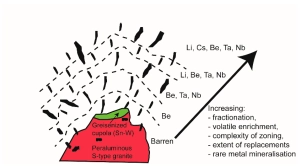Pegging the Right Pegmatite
Hard Rock Lithium Exploration
We know by now that pegmatites are what hard rock lithium explorers, the “white goldies” are pegging. It seems there’s not a week that goes by without another lithium pegmatite province announced… without another pegmatite drilling program commencing. It even seems that a new or expanded resource is being defined on a weekly basis. This plethora of hard rock lithium news is especially so in Western Australia, supplanting James Bay over the past six months.
What are pegmatites? What are the right pegmatites? What are the right lithium-bearing minerals in the right pegmatites?
There are an ever-growing number of junior hard rock lithium explorers in Australia. This is not especially difficult to understand, nor disingenuous of the explorer, when you consider where the sought-after pegmatites are popping up. Pegmatites occur in granite terrains, and the right pegmatites occur within greenstone belt rocks within granite terrains of a certain age and origin.
Think granite and greenstone belts, think the Yilgarn Craton.
Unsurprisingly, Yilgarn gold explorers are re-examining their gold-focussed RC drill chips for coarse crystals of quartz and feldspar. Some geologists have a UV light in their hands and finding fluorescent pink spodumene in the chip-trays.
The result… gold explorers across the Yilgarn are re-badging as dual gold and lithium explorers, or, if lacking meaningful gold, becoming white goldies, focussed solely on lithium. A segue from gold to white gold. It’s an irrepressible itch to scratch for many Aussie junior explorers looking for ways to attract investors, looking for ways to make mineral discoveries. If genuine, it’s to be commended.
There are already a dozen hard rock lithium deposits with economic potential on Western Australia’s Yilgarn and Pilbara granite-dominated geological provinces. The total Economic Demonstrated Resource (EDR) of these deposits is rapidly approaching 1billion tonnes at >1% Li2O. It’s a tenfold increase in 15 years.
Like kimberlites for diamonds, beach strands for heavy minerals, dry lakes for lithium brine, pegmatites are centre stage for hard rock lithium.
So…what are pegmatites?
I’m not going to get technical about this. Pegmatites are igneous rocks that form during the final stages of a cooling magma…. not a runny Hawaii-type lava, but a sticky magma way below the surface.
Pegmatites are characteristically coarse grained with large interlocking crystals.
The main components of pegmatites are quartz, felspar and mica. Because of the peculiarities of the process of a cooling magma, pegmatites often contain a suite of unusual minerals. It is these “accessory” minerals that are extracted for lithium, tin, tantalum, rare earth minerals, gems, etc…
Pegmatites that contain significant levels of the three elements lithium, caesium (cesium) and tantalum are called LCT pegmatites, and it is LCT pegmatites that are the real focus for hard rock lithium explorers.
LCT pegmatites
There are classifications of pegmatites that reflect depth of emplacement (and hence formation) regional setting, and mineral assemblage. LCT pegmatites are believed to occur within orogenic plutons (magmas in a tectonically active area, like at plate conversation/collision margins), and S-type granites that have been metamorphosed (squished and squeezed and cooked). In geological time, there appears to be particular phases of heightened LCT pegmatite development. Most seem to be associated with very old magmatic events, and hence occur on ancient crusts, like the Yilgarn, and the Pilbara.
S-type granites are granites derived from cooked up sediments, generally low in Na2O, and relatively high in Al2O3. Migmatites and leucogranites are examples of S-type granites.
LCT pegmatites typically comprise quartz (like all pegmatites), potassium feldspar, albite and muscovite. Typical accessory minerals include biotite, garnet, tourmaline and apatite.
Lithium minerals (discussed below) include spodumene, lepidolite and petalite. The caesium mineral is mainly pollucite and the tantalum mineral is mainly columbite-tantalite.
There is considerable amount of science behind the classification of LCT pegmatites, suffice it to say, and really all that is required to know is that LCT-pegmatites host elevated occurrences of minerals that contain lithium, caesium and tantalum.
Other Notable LCT Pegmatite Provinces
Quebec immediately comes to mind, and specifically the James Bay District. It too has an ever-increasing treasury of lithium growing beyond 300Mt at +1% Li2O. Like the Yilgarn and Pilbara, the setting is old granite, greenstone belts, structures and LCT pegmatites. What makes Quebec such a great hard rock lithium destination is that it has its own EV and EV battery “eco-system” with over 80 EV and EV-related enterprises. Think Tesla, VW, Ford, Stromvolt, EcoPro BM, etc…
LCT pegmatites of economic importance also occur in China, Mali, Ethiopia, the DRC, Zimbabwe, Portugal, and Brazil. Brazil has made some recent news about LCT pegmatites.
The Lithium-bearing Minerals of LCT Pegmatites – the Spodumene Focus
There are over a hundred different minerals that contain lithium. The minerals that are of economic interest in LCT pegmatites are spodumene, lepidolite and petalite… three types of aluminium silicate.
Despite the importance of spodumene, lepidolite and petalite, everyone is talking about spodumene. Why is that the case?
A part of the reason is that spodumene contains higher amounts of lithium than lepidolite and petalite.
Spodumene comprises 8.03% Li2O or 3.73% Li.
Lepidolite comprises 7.70% Li2O or 3.58% Li.
Petalite comprises 4.50% Li2O or 2.09% Li.
Spodumene has almost the double amount of lithium than petalite.
Let’s do some maths: For a LCT pegmatite to host 0.5% Li2O, being a reasonable cut-off grade for a hard rock lithium EDR, using the atomic weight amounts of lithium in spodumene, there needs to be 6.2% spodumene in the ore (the host pegmatite). The average grade of an LCT pegmatite lithium deposit appears to be a little north of 1% Li2O. That being the case, the LCT pegmatite ore needs to contain +/- 12.4% spodumene (simply double that calculated to achieve the 0.5% cut-off grade).
Another clue to the importance of spodumene above all other lithium-bearing minerals is that it is easier to recover from the (pegmatite) ore. Spodumene can be concentrated from its host pegmatite with crushing, dense media separation (DMS), floatation and magnetic separation. Sure, there are other techniques, but these largely non-chemical, low-energy requirements of separating spodumene from its host rock are hugely positive factors in terms of minimised environmental impact and lower costs.
Spodumene concentrate typically contains between 50% and 60% spodumene which equates to about 5% to 6% Li2O.
So it might be true to say that junior explorers are preferring to produce a spodumene concentrate rather than refined Li2O. These explorers might prefer to form partnerships or have off-take agreements with companies that have the ability to produce Li2O/Li from the spodumene concentrate. Such partnerships are appearing in ASX announcements already.
Exploration of LCT Pegmatites
The checklist of criteria for regional LCT pegmatite exploration [ground selection] includes the right granites (S-type), tectonics (orogenic), metamorphic rocks (greenstone belts), and the occurrence of structures (zones of weakness and traps for rising and fractionating magma).
Got that all ticked, then the explorer will focus on the project-scale criteria. Primarily, the occurrence of pegmatites and, it follows, the occurrence of LCT pegmatites.
Mapping and sampling are essential exploration activities, focussing on pegmatite emplacement structures, lithogeochemical analysis (the geochemistry of the rocks) and age dating. This is proof of concept stuff.
Looking for highly fractionated and “evolved” melts is key.
Finding biotite, tourmaline, and muscovite, as characteristic accessory minerals in LCT pegmatites is critical too. Finding spodumene is even better. Spodumene fluoresces pink under long-wave UV light. You’ll read about this too in ASX announcements of lithium explorers.
Rockchip sampling, stream sampling, grid soil sampling methods are all valid.
Pegmatites typically occur in clusters, and are regionally and internally zoned, so it is important to understand the nature of the pegmatite occurrence in terms of its position within the pegmatite cluster, and to understand the internal fabric and composition of the individual pegmatite. Too close to the originating granite, the pegmatite may be barren.
 From Steiner 2019, modified from Selway, et al, 2005.
From Steiner 2019, modified from Selway, et al, 2005.
Pegmatite zoning is not that straight forward also, and the science is by no means agreed. Even the vicinity of granite plutons is challenged in the formation of anatectic pegmatites, where LCT pegmatites may be located many kilometres indeed (>20km) from the parent magma.
It does seem evident though, albeit somewhat counterintuitive, that pegmatites occurring within the originating granite (the cooled magma) will not have the right formation conditions to host material levels of spodumene. Only those “a distance from” from granite may have spodumene.
Geophysics, such as magnetics and gravity, have some use as an exploration tool for LCT pegmatites, but only as an indirect measure. Magnetics may be useful to highlight structures (faults/fractures) in granites and metamorphic rocks that might be places where pegmatites have intruded. Gravity might show a pegmatite because it is less dense than the surrounding metamorphic sediment.
Radiometric surveys may be useful for highlighting gamma-ray responses of certain LCT pegmatite minerals, or very specially, the uranium which is a common element in pegmatites.
It really comes down to drilling the LCT pegmatite to obtain representative samples to determine the spodumene and hence lithium content of the intersected pegmatite. Large diameter (large sample) drilling techniques are preferred to overcome the “nugget effect” of potentially coarse spodumene. Pegmatites are typically far longer than they are wide. Angled, overlapping drill holes along short fences (lines) perpendicular to the pegmatite trend will be the go-to drill pattern. Explorers will differ on how they increase the potential resource… by step-out drilling, or by infill-drilling (or both).
As I’ve said in previous articles, I’ll stop my commentary at the drilling stage. I am not a mine geologist.
Summary
Hard rock lithium explorers look for spodumene-rich LCT pegmatites in regions dominated by S-type granites and medium to high grade metamorphic rocks (such as those in greenstone belts).
Mapping and sampling, plus or minus geophysics, helps find pegmatites. Rock studies (assays, fluid inclusion/thermometry, etc…) discern LCT pegmatites.
Successive drilling campaigns help define ever more reliable resources/reserves. Grades of spodumene in LCT pegmatites need to be +/-12% (containing 1% Li2O in assays).
Spodumene has a relatively high level of lithium in it compared to other lithium-bearing minerals. Spodumene has physical properties that makes it relatively inexpensive to beneficiate from the crushed pegmatite ore. Li2O is difficult to purify from spodumene concentrate so most hard rock lithium explorers look to produce spodumene concentrate only.




